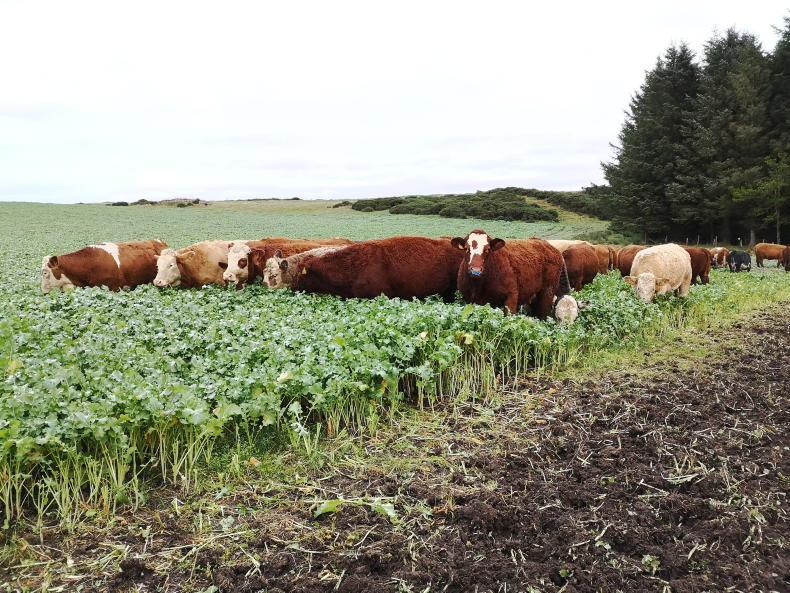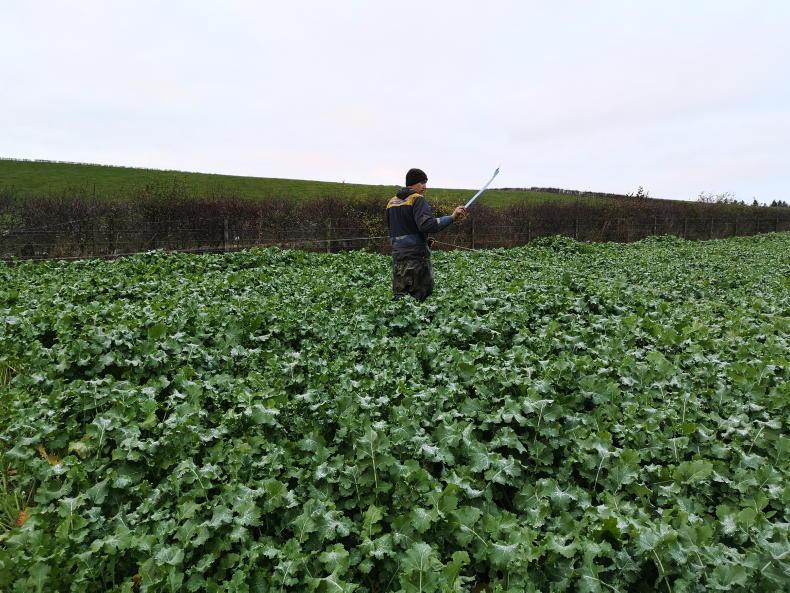The spring calvers at Cranna have now been scanned, with 10 empty from 108 cows to the bull. Arthur is not too pleased about the results. Two of the empty cows were the last to calve in the spring. Three others were bought-in heifers from the same farm whose calves all had cryptosporidium in the spring. All 10 empty cows are now being fattened for sale in February and March and Arthur will not be buying heifers from that source again.
After scanning, the Duguids have split the cows into three groups: fat, moderate and thin. The thin and fat cows have been housed. Meanwhile the 55 moderate cows have been put out to the 14 acres of Swift that were established in the summer. All being well, this should keep them into February, around six weeks pre-calving when they too will be housed.
“It is a good crop this year,” Arthur explained. “Better yield than last year. The plants are 36 inches at their tallest with most of the crop more than 30 inches high.”

The cows should stay on the kale until the start of February before coming inside to calve in March.
As a runback, the cattle have access to a grass field due for reseeding next spring. Here they are fed silage straw. A 550kg bale of straw is lasting five days and they are getting two bales of silage. This works out to 2kg of straw and 20kg of silage per head per day, or around half of their daily intake.
Last year, 42 cows grazed on 16 acres of Swift into the middle of February before coming inside for calving. However, they ate a lot more feed over the period to make up for the poorer yield.
This year’s Swift was sown on 17 July into an old grass sward. It was established using an Acheson direct drill for around £27/acre with the seed costing £21/acre. A day after sowing, the old grass was burned off at a cost of £10/acre. Finally 100kg of 24:7:7 fertiliser with sulphur was spread costing £310/t. This gives a total cost of £1,246 across the 14 acres, or £23/cow for the winter. Adding in the silage and straw, this gives a cost per cow per day of 91 pence.

Scott Duguid moves the fence each day for the 55 cows being outwintered.
Timing is key
Timing is everything in order to get a good fodder crop.
“We can’t plant beyond the end of July,” said Arthur. “Every day makes a difference to the size of the crop in winter. We usually aim for the middle of July and seem to get away with it.”
Grower advice
For anyone thinking of growing Swift or other hybrid brassicas, Arthur has the following advie.
“Firstly you need a dry park for the kale,” advised Arthur. “You also need a park to run back on to. Ideally you would have a road or some hard standing for feeding the cows their silage too.
“Shelter is also key for outwintering in Scotland. Our park has a wood and gorse which gives plenty shelter which on coarse days is vital.”
Arthur also recommends that outwintering is not an option for thin cows who need to build up their reserves. He does, however, believe that most cow types and breeds in Scotland can be outwintered on a brassica if they are in the right condition.
Cows on straw diet
The spring calvers which came off the grass in very good condition have been put on to a straw diet to get them ready for calving. This lower energy diet is cheaper than silage and also allows the cow to slim down for easy calving.
This year, Arthur choose 20 cows who had a “wide back and lots of fat” for the straw diet. The cows are eating a 400kg square bales of straight barley straw every two days which is costing around £18/bale. They are also getting a square bale of straw for bedding each week too, which is a lot less straw than the thin cows on the silage diet.
As straw alone is not a good enough feed, to supplement the diet the cows also have access to a high-protein molasses. This is costing 47p/l which is being fed out of a wheel feeder. The 200l feeder is lasting nine days. This gives a cost per cow per day of £1.10.
Autumn calving
Autumn calving has just about finished, with only two left to calve out of 57. Last time we caught up with Arthur he had to get the vet for five caesareans. However, luckily the second half of the calving saw no return of the vet. If the final two cows calve successfully this will give a calving percentage of 91%.
For ease of management, Arthur is a big believer in feeding the cows later in the day to reduce the number of births at night. The autumn calvers are fed around 6pm and the spring calvers are not fed until after 8pm which has seen a reduction in the number of cows calving through the night.
The cycle starts again
The bull is heading in with next year’s autumn calvers on 21 December and will be in for nine weeks, which is three shorter than last year. Arthur is keen to tighten up the calving spread as the family continue to make progress at Cranna.
The spring calvers at Cranna have now been scanned, with 10 empty from 108 cows to the bull. Arthur is not too pleased about the results. Two of the empty cows were the last to calve in the spring. Three others were bought-in heifers from the same farm whose calves all had cryptosporidium in the spring. All 10 empty cows are now being fattened for sale in February and March and Arthur will not be buying heifers from that source again.
After scanning, the Duguids have split the cows into three groups: fat, moderate and thin. The thin and fat cows have been housed. Meanwhile the 55 moderate cows have been put out to the 14 acres of Swift that were established in the summer. All being well, this should keep them into February, around six weeks pre-calving when they too will be housed.
“It is a good crop this year,” Arthur explained. “Better yield than last year. The plants are 36 inches at their tallest with most of the crop more than 30 inches high.”

The cows should stay on the kale until the start of February before coming inside to calve in March.
As a runback, the cattle have access to a grass field due for reseeding next spring. Here they are fed silage straw. A 550kg bale of straw is lasting five days and they are getting two bales of silage. This works out to 2kg of straw and 20kg of silage per head per day, or around half of their daily intake.
Last year, 42 cows grazed on 16 acres of Swift into the middle of February before coming inside for calving. However, they ate a lot more feed over the period to make up for the poorer yield.
This year’s Swift was sown on 17 July into an old grass sward. It was established using an Acheson direct drill for around £27/acre with the seed costing £21/acre. A day after sowing, the old grass was burned off at a cost of £10/acre. Finally 100kg of 24:7:7 fertiliser with sulphur was spread costing £310/t. This gives a total cost of £1,246 across the 14 acres, or £23/cow for the winter. Adding in the silage and straw, this gives a cost per cow per day of 91 pence.

Scott Duguid moves the fence each day for the 55 cows being outwintered.
Timing is key
Timing is everything in order to get a good fodder crop.
“We can’t plant beyond the end of July,” said Arthur. “Every day makes a difference to the size of the crop in winter. We usually aim for the middle of July and seem to get away with it.”
Grower advice
For anyone thinking of growing Swift or other hybrid brassicas, Arthur has the following advie.
“Firstly you need a dry park for the kale,” advised Arthur. “You also need a park to run back on to. Ideally you would have a road or some hard standing for feeding the cows their silage too.
“Shelter is also key for outwintering in Scotland. Our park has a wood and gorse which gives plenty shelter which on coarse days is vital.”
Arthur also recommends that outwintering is not an option for thin cows who need to build up their reserves. He does, however, believe that most cow types and breeds in Scotland can be outwintered on a brassica if they are in the right condition.
Cows on straw diet
The spring calvers which came off the grass in very good condition have been put on to a straw diet to get them ready for calving. This lower energy diet is cheaper than silage and also allows the cow to slim down for easy calving.
This year, Arthur choose 20 cows who had a “wide back and lots of fat” for the straw diet. The cows are eating a 400kg square bales of straight barley straw every two days which is costing around £18/bale. They are also getting a square bale of straw for bedding each week too, which is a lot less straw than the thin cows on the silage diet.
As straw alone is not a good enough feed, to supplement the diet the cows also have access to a high-protein molasses. This is costing 47p/l which is being fed out of a wheel feeder. The 200l feeder is lasting nine days. This gives a cost per cow per day of £1.10.
Autumn calving
Autumn calving has just about finished, with only two left to calve out of 57. Last time we caught up with Arthur he had to get the vet for five caesareans. However, luckily the second half of the calving saw no return of the vet. If the final two cows calve successfully this will give a calving percentage of 91%.
For ease of management, Arthur is a big believer in feeding the cows later in the day to reduce the number of births at night. The autumn calvers are fed around 6pm and the spring calvers are not fed until after 8pm which has seen a reduction in the number of cows calving through the night.
The cycle starts again
The bull is heading in with next year’s autumn calvers on 21 December and will be in for nine weeks, which is three shorter than last year. Arthur is keen to tighten up the calving spread as the family continue to make progress at Cranna.








 This is a subscriber-only article
This is a subscriber-only article










SHARING OPTIONS: